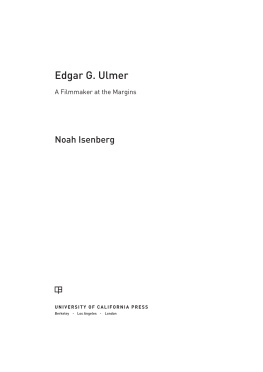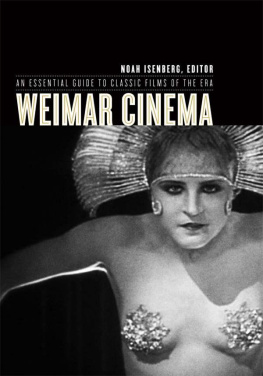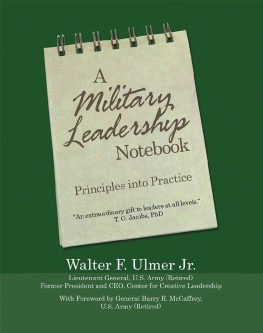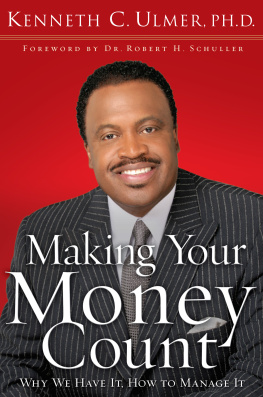
The publisher gratefully acknowledges the generous support of the Humanities Endowment Fund of the University of California Press Foundation.
Edgar G. Ulmer
WEIMAR AND NOW: GERMAN CULTURAL CRITICISM
Edward Dimendberg, Martin Jay, and Anton Kaes, General Editors
Edgar G. Ulmer
A Filmmaker at the Margins
Noah Isenberg

UNIVERSITY OF CALIFORNIA PRESS
BerkeleyLos AngelesLondon
University of California Press, one of the most distinguished university presses in the United States, enriches lives around the world by advancing scholarship in the humanities, social sciences, and natural sciences. Its activities are supported by the UC Press Foundation and by philanthropic contributions from individuals and institutions. For more information, visit www.ucpress.edu.
University of California Press
Berkeley and Los Angeles, California
University of California Press, Ltd.
London, England
2014 by The Regents of the University of California
Library of Congress Cataloging-in-Publication Data
Isenberg, Noah William.
Edgar G. Ulmer : a filmmaker at the margins / Noah Isenberg.
pagescm. (Weimar and now: German cultural criticism)
Includes bibliographical references and index.
ISBN 978-0-520-23577-9 (cloth : alk. paper)
ISBN 978-0-520-95717-6 (ebook)
1. Ulmer, Edgar G. (Edgar George), 19041972.2. Motion picture producers and directorsUnited StatesBiography.I. Title.
PN 1998.3. U 46I84 2013
791.430233092dc23
[B]2013025957
Manufactured in the United States of America
22 21 20 19 18 17 16 15 14
10 9 8 7 6 5 4 3 2 1
In keeping with a commitment to support environmentally responsible and sustainable printing practices, UC Press has printed this book on Natures Natural, a fiber that contains 30% post-consumer waste and meets the minimum requirements of ANSI/NISO Z 39.48-1992 ( R 1997) ( Permanence of Paper ).
To Melanie, Jules, and Bruno
and in memory of
Jon Irwin Isenberg (19372003)
and
Hanu Georg Rehak (19272006)
Contents
Illustrations
Preface
The origins of this project lie in a conversation I had more than a decade ago. I was sitting on the redwood deck at my mothers house in La Jolla, California, and her companion of many years, Bob Lurie, was talking with me about my current teaching and research interests. An adman by profession, Bob had a keen understanding of film, particularly of the glory days of Hollywood in the 1940s and 1950s, when hed lived in Los Angeles, having moved there from New York to attend UCLA on the GI Bill. I happened to mention to Bob that a director who really intrigued me, whose films I had taught in several of my courses, was one of Hollywoods European transplants, a lesser-known figure among the celebrated lot, a guy named Edgar G. Ulmer. The very mention of his name prompted an outburst. Dont believe a word he said! Bob exclaimed. As fate would have it, Bobs first cousin was Shirley Ulmer, Edgars wife and lifelong collaborator. Bob had sat through many a meal with the director holding court and telling some of the tallest of his tales, and he wasnt buying any of it.
This, naturally, made me only more eager to explore the career of this enigmatic director, a man who clearly had talent but repeatedly exaggerated his accomplishments and affiliations, especially late in life, in such a way as to provoke total disbelief. I needed to find out more, so Bob offered to put me in touch with Shirley Ulmer. My calls went unanswered until one autumn evening in 2001, when I heard from Shirleys daughter, Ariann, a former actor, who told me that Shirley had recently passed away. Ariann, however, had not only acted in several of her fathers films but ran the Edgar G. Ulmer Preservation Corp. out of her home office on Stone Canyon Road in Sherman Oaks, California. Not long after that, I boarded a plane from New York to Los Angeles to visit Ariann, whose passion, commitment, and charm came across even over the phone. Together we combed through the many boxes of materialsphotos, letters, diaries, other unpublished manuscriptsshe and her mother had been holding on to since her fathers death nearly thirty years earlier. I gathered as much material as I could, then worked my way through the various papers kept at the Margaret Herrick Library of the Academy of Motion Picture Arts and Sciences. In addition, I watched and rewatched all of Ulmers movies, some on duped videocassettes, some in brittle 16 mm prints viewed on a flatbed editing table, some on newly released DVDs, and some on the big screen.
From California the journey continued onward to Vienna, where I spent the winter and spring of 2003 as a fellow at the International Research Center for Cultural Studies, trying to uncover details about Ulmers childhood and initial training in theater and film. While there, I often found myself reaching a series of dead ends: no records at the primary and secondary schools he purportedly attended; no definitive proof of his contributions to various early productions; no confirmation of the formal education he later claimed to have had. I continued to wade through the archives and follow up on numerous leads provided by friends and colleagues at the Austrian Film Museum and by journalist Stefan Grissemann, who had just published his German-language biography of Ulmer, Mann im Schatten: Der Filmemacher Edgar G. Ulmer (Man in the shadows: The filmmaker Edgar G. Ulmer) that same year. But the itinerant director seemed, either unwittingly or very craftily, to have covered his tracks. What made Ulmer marginal was not merely that he tended, over his thirty-five-year career as a director, to work in offbeat markets (B studios, Hollywoods underground, European independents), and to traffic in eclectic genres (horror, race pictures, health shorts, film noir, costume dramas, science fiction), but that the details of his own life were tucked away somewhere in the dark corners of history.
I left Austria after four months with a somewhat better picture of Ulmer but many mysteries unsolved. Luckily, in the final days of my stint in Vienna I had made a trip to Berlin, where I discovered a large cache of letters kept in the Paul Kohner Archives between Ulmer and his agent Ilse Lahn at the Kohner Office, mainly documenting his European productions from the 1940s, 1950s, and 1960s. I saw immediately that to tell a fuller story of Ulmer, it would be necessary to include the lively, occasionally tense, discussions that he, Shirley, and Lahnwith periodic input by Kohner himselfcarried out during the final decades of his professional life. I knew I would have to return to Berlin, the place where Ulmer had his seemingly auspicious directorial debut three-quarters of a century earlier.
But while Ulmer began his career with such renowned migr directors as Robert Siodmak, Fred Zinnemann, and Billy Wilderall of whom collaborated on the celebrated late silent classic Menschen am Sonntag ( People on Sunday, 1930)he never enjoyed the same sort of commercial success or big-studio backing as did others in his cohort of Austrian and German-born filmmakers in America. To compare Ulmer to those great, triumphant studio careers and to the dominant rags-to-riches Hollywood mythology, though, is in many ways to fail to see Ulmers career on its own terms. It isnt as if Wilder remained an unsung outcast in his own time, observes Ed Sikov early on in his biography of Billy Wilder, a lone artist rubbing against the grain of his culture. Indeed, thats a description far more befitting of Ulmer than of his illustrious counterparts in the film business.
Next page












